Wildlife of Brazil
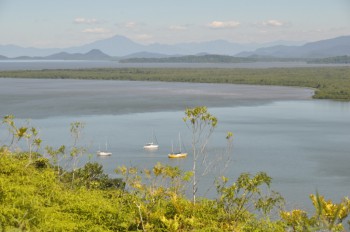
In a small, isolated village in southern Brazil, the long, hot day is finally ending. From our yacht, anchored out in the river, we watch the sun sink slowly into the mangroves, lighting up the clouds like tufts of pink candy-floss, and streaking the water with rainbow colours as though it had been mixed with oil. The characteristic sounds of the Brazilian daytime – motorbikes, the shrill screaming of cicadas, and the sound of Roberto Carlos’ latest hit being played in six different places – all gradually fade out.
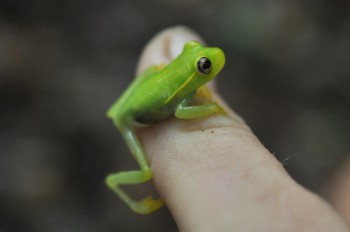
At this time of day, there is only one thing loud enough to drown out the noise of preachers, in all the local churches, competing with each other – the sound of millions of tiny creatures singing in chorus; the shrill buzzing of the crickets, the rapid stuttering of the tree frogs, and an occasional echoing cry from some type of nocturnal bird. Large bats start to flap jerkily over the dark surface of the water, weaving and dodging to snatch an insect out of the air, and darting up through the rigging of the boat like shadows.
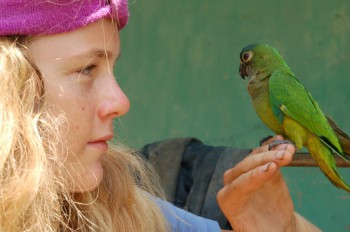
Brazil is famous for its exotic forms of life. Children living in tame, predictable towns in cultivated England are taught about talkative and brightly coloured parrots, plants which devour animals, and wide-eyed frogs whose venom is potent enough for the murderous natives to poison their arrows with. Stepping into the forest can be a bit of an anticlimax. It seems, at first, to be not very different from any forest in Europe.
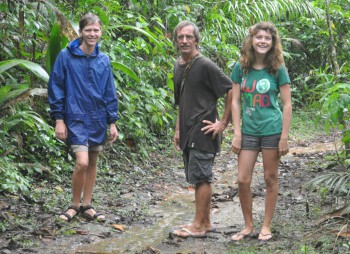
The ordinary-looking trees overhanging the path were interspersed with the occasional bedraggled coconut palm, growing high out of the tangled mass of other plants in its search for light. The only immediate signs of animal life were the little, yellow-breasted kiskadees, probably the commonest bird in South America, as they chased each other loudly from branch to branch. There was a rustling among the trees in front of us, and a boy came running down the track, pushing a wheelbarrow of firewood ahead of him.
“There are loads of huge crocodiles in that stream.” he told us, with an ill-concealed grin, waving his arm back in the direction he’d emerged from. The muddy trickle of water, when we reached it, didn’t seem to harbour anything fiercer then a tadpole, and we decided he’d probably started the rumour to scare the tourists.
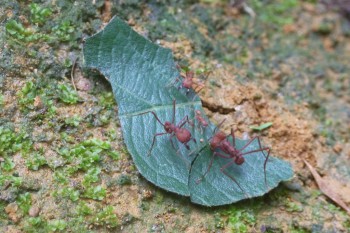
On the ground ahead of us, a column of bright green leaves was snaking its way across the brown mud. Subsequent examination revealed that each one had a large ant clinging to the bottom of it. They marched in ranks back towards their nest, holding their leaves in the air like flags. When they reached its entrance – an inconspicuous hole in the ground – their cargo was taken over by their slightly smaller siblings, who would probably never venture outside the threshold of their colony.
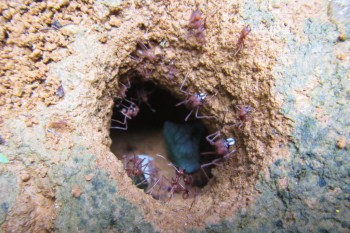
Leaf cutter ants have various different castes of workers, ranging from the largest, whose job it is to harvest leaves and protect the colony, to the smallest, less than a hundredth of their size, who spend their lives tending the ants’ ‘gardens’. The leaves were not being collected for food, instead they would be chewed into a paste and carried down to underground chambers, to be used as compost in the ants’ fungus gardens. The ants eat the fungus.
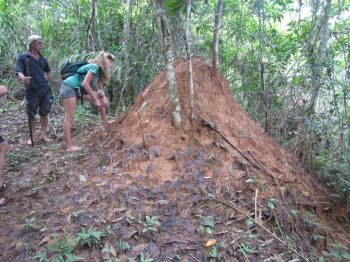
Some other insects with a rather similar life style – although actually not particularly closely related to the ants – were also living in colonies throughout the forest. What at first glance appeared to be gigantic piles of earth, heaped on the ground or in the branches of trees, were actually massive colonies of millions of individual termites. Termites eat wood, thereby making themselves extremely unpopular with people who live in wooden buildings, but they are rather more secretive then the ants, and instead of foraging out in the open they prefer to construct tunnels to their source of food.
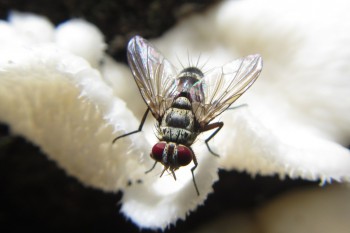
All of the trees had tiny, protruding tunnels running up them, as though they had been embossed on the bark, and if you flicked away the paper-thin wall you uncovered the line of white, eyeless little animals hurrying up and down the trunk. But not for very long; within a few minutes the industrious creatures would have completely rebuilt the break in the tunnel, gluing specks of sawdust together with their saliva.
The combined weight of all the individual ants in a Brazilian forest is said to add up to as much as four times that of all the mammals and other animals put together. Add the termites, as well, and their combined effect on the forest must be astronomical.
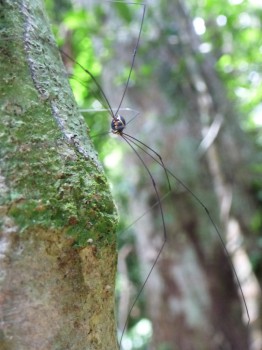
Some other arthropods which are particularly noticeable are the spiders, not so much because of their abundance as because of their large size. A lot of the branches had symmetrical, beautifully-woven webs stretching between them, hung with glistening beads of moisture. Most of the spiders poised in the middle of them were orb-web spiders, their bodies speckled with yellow and black, and some of the larger ones were big enough to tackle a humming bird – should a humming bird be absent minded enough to fly into their web.
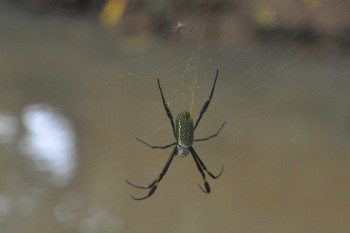
All of the webs belonged to female spiders, but a few of the tiny, drab males were lurking on the edge of each, presumably hoping for an opportunity to mate. The enormous difference in size between the male and female is sometimes explained as a survival tactic on the part of the male – in many species of spider, the female kills and eats the male after mating with him, but with orb-web spiders he’s said to be too small for her to bother eating.
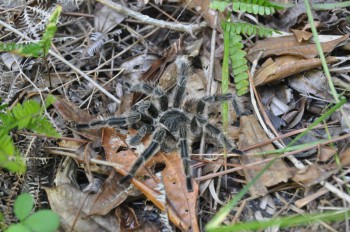
The orb web spiders aren’t the largest spiders in the forest. The tarantulas are much bigger, although despite their large size they are nowhere near as dangerous as some of the other, smaller spiders in the forest. Tarantulas are mostly nocturnal, and this combined with their rather shy habits meant that we rarely saw them. They prey on large insects and small mammals and lizards, and a particularly large and enterprising species of wasp preys on them. If the wasp manages to paralyse a spider with her sting she will drag it back to her underground nest and use it as food for her offspring. Sometimes the tarantula wins, and it eats the wasp instead.
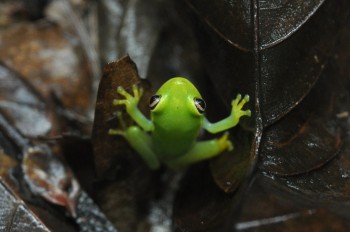
The leaves covering the forest floor are alive with other tiny insects and animals, getting on with their individual lives and preying on each other. Locals frequently warned us that the forest was full of poisonous snakes. We never came across one of them, but we did meet a tiny, bright green tree frog, shining as though someone had just applied a coat of varnish to him. He was hopping along the path on some mission of his own.
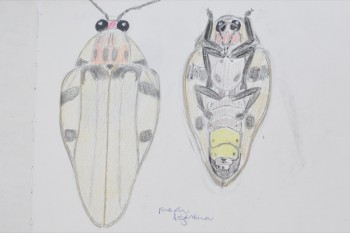
In the night, fireflies appear in their hundreds, flying from tree to tree and filling the black forest with drifting specks of pulsing light. They spend the rest of their time down on the ground hunting snails, which they immobilise with minute injections of poison and then transform with their saliva into a liquid ‘soup’ which they feast on.
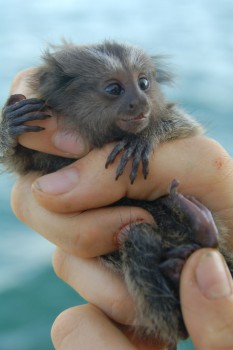
An outbreak of shrill whistling burst from the tree above us. We glanced up, expecting to see some type of bird, but the scolding came from a group of little tamarind monkeys glaring down at us, their tails like black and white striped bottle brushes. They were saguines, one of the smallest, commonest, and most inquisitive of the Brazilian monkeys, and we often saw them in towns, running along the telegraph wires in acrobatic leaps like a troupe of miniature tight-rope walkers. Sometimes, when we were aboard our boat, a reverberating series of howls and calls would start up in the trees nearby, announcing the presence of a much larger species of monkey. The locals, with disinterested Brazilian shrugs, simply told us that they were apes.
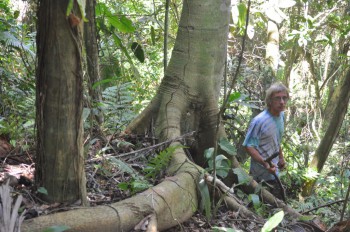
The forest was clearly a complete, fantastically complicated ecosystem, of thousands of species of animals and plants surviving around each other. Today, with an enormous amount of forests disappearing because of mankind’s greedy activities, a lot of these species risk extinction – but in this particular Brazilian forest, as yet, everything seems to be carrying on as normal.
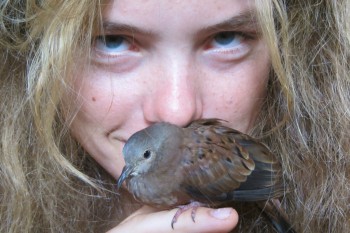
If you would like Roxanne to write more articles about the wildlife which we encounter, and about ecology and the environment, please drop her line using the contact form or leave a comment, below.
